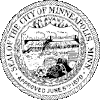Minneapolis
Minneapolis | |
|---|---|
| City of Minneapolis | |
| SVG map of Hennepin County and unincorporated areas showing location of Minneapolis | |
|
Official logo of Minneapolis City Logo | |
| Nickname(s): "City of Lakes", "Mill City", "Twin Cities" (a nickname shared with Saint Paul), "Mini Apple" | |
| Motto: En Avant (French: 'Forward') | |
 Location in Hennepin County and the state of Minnesota | |
| Country | United States of America |
| State | Minnesota |
| County | Hennepin |
| Incorporated | 1867 |
| Founded by | John H. Stevens and Franklin Steele |
| Named for | Dakota word "minnehaha" meaning waterfall with Greek word "polis" for city |
| Government | |
| • Type | Weak mayor–council |
| • Body | Minneapolis City Council |
| • Mayor | Betsy Hodges (DFL) |
| Area | |
• City | 58.4 sq mi (151.3 km2) |
| • Land | 54.9 sq mi (142.2 km2) |
| • Water | 3.5 sq mi (9.1 km2) |
| Elevation | 830 ft (264 m) |
| Population | |
• City | 382,578 |
• Estimate (2012[2]) | 392,880 |
| • Rank | US: 47th |
| • Density | 7,019.6/sq mi (2,710.1/km2) |
| • Metro | 3,422,264 (16th) |
| • Demonym | Minneapolitan |
| Time zone | UTC-6 (CST) |
| • Summer (DST) | UTC-5 (CDT) |
| ZIP codes | 55401 – 55488 (range includes some zip codes which are for Minneapolis suburbs) |
| Area code | 612 |
| FIPS code | 27-43000Template:GR |
| GNIS feature ID | 0655030Template:GR |
| Website | www.MinneapolisMN.gov |
Minneapolis (/ˌmɪniˈæpəlɪs/ ), officially the City of Minneapolis, is the county seat of Hennepin County,Template:GR the largest city in the U.S. state of Minnesota, and the 47th-largest in the United States. As of 2012, the estimated population of the city of Minneapolis was 392,880.[3] Minneapolis lies on both banks of the Mississippi River, just north of the river's confluence with the Minnesota River, and adjoins Saint Paul, the state's capital. Known as the Twin Cities, Minneapolis–Saint Paul is the 16th-largest metropolitan area in the U.S., with the area containing approximately 3.8 million residents.[4]
The city is abundantly rich in water, with twenty lakes and wetlands, the Mississippi River, creeks and waterfalls, many connected by parkways in the Chain of Lakes and the Grand Rounds National Scenic Byway. It was once the world's flour milling capital and a hub for timber, and today is the primary business center between Chicago and Seattle, with Minneapolis proper containing America's fifth-highest concentration of Fortune 500 companies.[5][6] As an integral link to the global economy, Minneapolis is categorized as a global city.[7]
Minneapolis's name is attributed to the city's first schoolteacher, who combined mni, a Dakota Sioux word for water, and polis, the Greek word for city.[8][9]
History
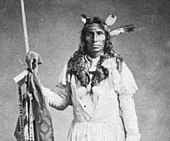
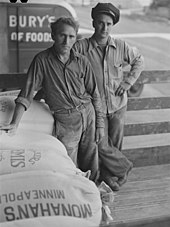
Dakota Sioux were the region's sole residents until French explorers arrived around 1680. Nearby Fort Snelling, built in 1819 by the United States Army, spurred growth in the area. The United States government pressed the Mdewakanton band of the Dakota to sell their land, allowing people arriving from the east to settle there. The Minnesota Territorial Legislature authorized present-day Minneapolis as a town on the Mississippi's west bank in 1856. Minneapolis incorporated as a city in 1867, the year rail service began between Minneapolis and Chicago. It later joined with the east-bank city of St. Anthony in 1872.[11]
Minneapolis grew up around Saint Anthony Falls, the highest waterfall on the Mississippi. In early years, forests in northern Minnesota were the source of a lumber industry that operated seventeen sawmills on power from the waterfall. By 1871, the west river bank had twenty-three businesses including flour mills, woolen mills, iron works, a railroad machine shop, and mills for cotton, paper, sashes, and planing wood.[12] Due to occupational hazards of milling, six local sources of artificial limbs were competing in the prosthetics business by the 1890s.[13] The farmers of the Great Plains grew grain that was shipped by rail to the city's thirty-four flour mills. Millers have used hydropower elsewhere since the 1st century B.C.,[14] but the results in Minneapolis between 1880 and 1930 were so remarkable the city has been described as "the greatest direct-drive waterpower center the world has ever seen."[15]
A father of modern milling in America and founder of what became General Mills, Cadwallader C. Washburn converted his business from gristmills to truly revolutionary technology including "gradual reduction" processing by steel and porcelain roller mills which were capable of producing premium-quality pure white flour very quickly.[16][17] Some ideas were developed by William Dixon Gray[18] and some through industrial espionage from the Hungarians by William de la Barre.[17] Charles A. Pillsbury and C.A. Pillsbury Company across the river were barely a step behind, hiring Washburn employees to immediately implement the new methods.[17] The hard red spring wheat that grows in Minnesota became valuable ($.50 profit per barrel in 1871 increased to $4.50 in 1874[16]) and Minnesota "patent" flour was recognized at the time as the best in the world.[17] Millers cultivated relationships with academic scientists especially at the University of Minnesota. Those scientists backed them politically on many issues, for example during the early 20th century, when health advocates in the nascent field of nutrition criticized the flour "bleaching" process.[17] At peak production, a single mill at Washburn-Crosby made enough flour for 12 million loaves of bread each day.[19] By 1900, 14.1 percent of America's grain was milled in Minneapolis.[16][17]
Known initially as a kindly physician, Doc Ames headed the city into corruption during four terms as mayor just before 1900.[20] The gangster Kid Cann was famous for bribery and intimidation during the 1930s and 1940s.[21] The city made dramatic changes to rectify discrimination as early as 1886 when Martha Ripley founded Maternity Hospital for both married and unmarried mothers.[22] When the country's fortunes turned during the Great Depression, the violent Teamsters Strike of 1934 resulted in laws acknowledging workers' rights.[23] A lifelong civil rights activist and union supporter, mayor Hubert Humphrey helped the city establish fair employment practices and a human relations council that interceded on behalf of minorities by 1946.[24] In the 1950s, about 1.6% of the population of Minneapolis was nonwhite.[25] Minneapolis contended with white supremacy, participated in desegregation and the African-American civil rights movement, and in 1968 was the birthplace of the American Indian Movement.[26]
Minneapolis was a "particularly virulent" site of anti-semitism until 1950. A hate group recruited members in the city and held meetings there around 1936 to 1938. The Jewish Free Employment Bureau tried to help victims of economic discrimination with limited success. Formed in 1948, the nonsectarian Mount Sinai Hospital was a place where Jewish physicians and health professionals could practice.[27][28]
During the 1950s and 1960s, as part of urban renewal, the city razed about 200 buildings across 25 city blocks (roughly 40% of downtown), destroying the Gateway District and many buildings with notable architecture including the Metropolitan Building. Efforts to save the building failed but are credited with sparking interest in historic preservation in the state.[29]
Geography and climate
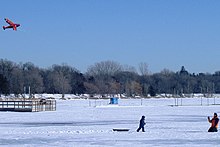
The history and economic growth of Minneapolis are tied to water, the city's defining physical characteristic, which was brought to the region during the last ice age ten thousand years ago. Ice blocks deposited in valleys by retreating glaciers created the lakes of Minneapolis.[30] Fed by a receding glacier and Lake Agassiz, torrents of water from a glacial river cut the Mississippi riverbed and created the river's only waterfall, St. Anthony Falls, important to the early settlers of Minneapolis.[31]
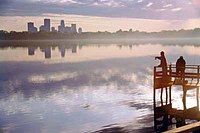
Lying on an artesian aquifer[5] and flat terrain, Minneapolis has a total area of 58.4 square miles (151.3 km2) and of this 6% is water.[32] Water is managed by four watershed districts that correspond to the Mississippi and the city's three creeks.[33] Twelve lakes, three large ponds, and five unnamed wetlands are within Minneapolis.[33]
The city center is located at 45° N latitude.[34] The city's lowest elevation of 686 feet (209 m) is near where Minnehaha Creek meets the Mississippi River. The site of the Prospect Park Water Tower is often cited as the city's highest point[35] and a placard in Deming Heights Park denotes the highest elevation, but a spot at 974 feet (297 m) in or near Waite Park in Northeast Minneapolis is corroborated by Google Earth as the highest ground.
Cityscape
Climate
Minneapolis has a continental climate typical of the Upper Midwest. Winters are cold and snowy, while summers are hot and humid. On the Köppen climate classification, Minneapolis falls in the hot summer humid continental climate zone (Dfa) and is situated in USDA plant hardiness zone 5a/4b.[36] As is typical in a continental climate, the difference between average temperatures in the coldest winter month and the warmest summer month is great: 60.1 °F (33.4 °C).
The city experiences a full range of precipitation and related weather events, including snow, sleet, ice, rain, thunderstorms, tornadoes, heatwaves, and fog. Extreme temperatures for Minneapolis range from 108 °F (42 °C) in July 1936 down to −41 °F (−41 °C) in January 1888. The snowiest winter of record was 1983–84, when 98.4 inches (250 cm) of snow fell.[37]
Template:Minneapolis weatherbox
Demographics
| Census | Pop. | Note | %± |
|---|---|---|---|
| 1860 | 5,809 | — | |
| 1870 | 13,066 | 124.9% | |
| 1880 | 46,887 | 258.8% | |
| 1890 | 164,738 | 251.4% | |
| 1900 | 202,718 | 23.1% | |
| 1910 | 301,408 | 48.7% | |
| 1920 | 380,582 | 26.3% | |
| 1930 | 464,356 | 22.0% | |
| 1940 | 492,370 | 6.0% | |
| 1950 | 521,718 | 6.0% | |
| 1960 | 482,872 | −7.4% | |
| 1970 | 434,400 | −10.0% | |
| 1980 | 370,951 | −14.6% | |
| 1990 | 368,383 | −0.7% | |
| 2000 | 382,618 | 3.9% | |
| 2010 | 382,578 | 0.0% | |
| 2012 (est.) | 392,880 | 2.7% | |
2012 Estimate[39] | |||
As of the 2010 U.S. census, the racial composition was as follows:[40][41]
- White: 63.8%
- Black or African American: 18.6%
- American Indian: 2.0%
- Asian: 5.6% (1.9% Hmong, 0.9% Chinese, 0.7% Indian, 0.6% Korean, 0.4% Vietnamese, 0.3% Thai, 0.3% Laotian, 0.2% Filipino, 0.1% Japanese, 0.2% Other Asian)
- Native Hawaiian/Pacific Islander: 0.1%
- Other: 5.6%
- Multiracial: 4.4%
- Hispanic or Latino (of any race): 10.5%[42] (7.0% Mexican, 1.3% Ecuadorian, 0.4% Puerto Rican, 0.3% Guatemalan, 0.2% Salvadoran, 1.3% Other Latino)

White Americans make up about three-fifths of Minneapolis's population. This community is predominantly of German and Scandinavian descent. There are 82,870 German Americans in the city, making up over one-fifth (23.1%) of the population. The Scandinavian American population is primarily Norwegian and Swedish. There are 39,103 Norwegian Americans, making up 10.9% of the population; there are 30,349 Swedish Americans, making up 8.5% of the city's population. Danish Americans are not nearly as numerous; there are 4,434 Danish Americans, making up only 1.3% of the population. Norwegian, Swedish, and Danish Americans together make up 20.7% of the population. This means that Germans and Scandinavians together make up 43.8% of Minneapolis's population, and make up the majority of Minneapolis's non-Hispanic white population. Other significant European groups in the city include those of Irish (11.3%), English (7.0%), Polish (3.9%), French (3.5%) and Italian (2.3%) descent.[43]
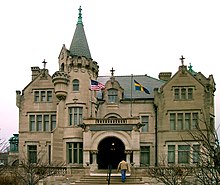
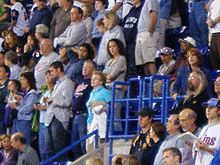
There are 10,711 multiracial individuals in Minneapolis. People of black and white ancestry number at 3,551, and make up 1.0% of the population. People of white and Native American ancestry number at 2,319, and make up 0.6% of the population. Those of white and Asian ancestry number at 1,871, and make up 0.5% of the population. Lastly, people of black and Native American ancestry number at 885, and make up 0.2% of Minneapolis's population.[46]
Dakota tribes, mostly the Mdewakanton, as early as the 16th century were known as permanent settlers near their sacred site of St. Anthony Falls.[11] New settlers arrived during the 1850s and 1860s in Minneapolis from New England, New York, and Canada, and during the mid-1860s, immigrants from Finland and Scandinavians (from Sweden, Norway and Denmark) began to call the city home. Migrant workers from Mexico and Latin America also interspersed.[47] Later, immigrants came from Germany, Italy, Greece, Poland, and Southern and Eastern Europe. These immigrants tended to settle in the Northeast neighborhood, which still retains an ethnic flavor and is particularly known for its Polish community. Jews from Russia and Eastern Europe began arriving in the 1880s and settled primarily on the north side of the city before moving in large numbers to the western suburbs in the 1950s and 1960s.[48] Asians came from China, the Philippines, Japan, and Korea. Two groups came for a short while during U.S. government relocations: Japanese during the 1940s, and Native Americans during the 1950s. From 1970 onward, Asians arrived from Vietnam, Laos, Cambodia, and Thailand. Beginning in the 1990s, a large Latino population arrived, along with immigrants from the Horn of Africa, especially Somalia.[49] The metropolitan area is an immigrant gateway which had a 127% increase in foreign-born residents between 1990 and 2000.[50]
U.S. Census Bureau estimates in the year 2007 show the population of Minneapolis to be 377,392, a 1.4% drop since the 2000 census. The population grew until 1950 when the census peaked at 521,718, and then declined as people moved to the suburbs until about 1990.
Among U.S. cities as of 2006, Minneapolis has the fourth-highest percentage of gay, lesbian, or bisexual people in the adult population, with 12.5% (behind San Francisco, and slightly behind both Seattle and Atlanta).[51][52] In 2012, The Advocate named Minneapolis the seventh gayest city in America.[53] In 2013, the city was among 25 U.S. cities to receive the highest possible score from the Human Rights Campaign, signifying its support for LGBT residents.[54]
Racial and ethnic minorities lag behind white counterparts in education, with 15.0% of blacks and 13.0% of Hispanics holding bachelor's degrees compared to 42.0% of the white population. The standard of living is on the rise, with incomes among the highest in the Midwest, but median household income among minorities is below that of whites by over $17,000. Regionally, home ownership among minority residents is half that of whites though Asian home ownership has doubled. In 2000, the poverty rate for whites was 4.2%; for blacks it was 26.2%; for Asians, 19.1%; Native Americans, 23.2%; and Hispanics, 18.1%.[50][55][56]
| U.S. Census Population Estimates | |||||||||||||||||
|---|---|---|---|---|---|---|---|---|---|---|---|---|---|---|---|---|---|
| Year | 1860 | 1870 | 1880 | 1890 | 1900 | 1910 | 1920 | 1930 | 1940 | 1950 | 1960 | 1970 | 1980 | 1990 | 2000 | 2010 | 2012 Estimate |
| Population | 5,809 | 13,800 | 46,887 | 164,738 | 202,718 | 301,408 | 380,582 | 464,356 | 492,370 | 521,718 | 482,872 | 434,400 | 370,951 | 368,383 | 382,618 | 382,578 | 392,880 |
| U.S. Rank[57][58] | — | — | 38 | 18 | 19 | 18 | 18 | 15 | 16 | 17 | 25 | 32 | 34 | 42 | 45 | 48 | 47 |
Economy
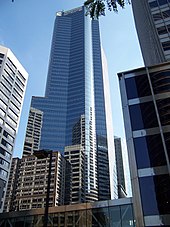
The Minneapolis–St. Paul area is the second largest economic center in the Midwest, behind Chicago. The economy of Minneapolis today is based in commerce, finance, rail and trucking services, health care, and industry. Smaller components are in publishing, milling, food processing, graphic arts, insurance, education, and high technology. Industry produces metal and automotive products, chemical and agricultural products, electronics, computers, precision medical instruments and devices, plastics, and machinery.[59] The city at one time produced farm implements.[60]
Five Fortune 500 corporations make their headquarters within the city limits of Minneapolis: Target, U.S. Bancorp, Xcel Energy, Ameriprise Financial and Thrivent Financial for Lutherans.[61] As of 2009 the city's largest employers are Target, University of Minnesota, Allina Health, Fairview Health Services, Wells Fargo, Hennepin County, Ameriprise, Hennepin County Medical Center, U.S. Bancorp, City of Minneapolis, Xcel Energy, Capella Education Company, RBC Wealth Management, Macy's, TCF Financial, Federal Reserve Bank of Minneapolis, Thrivent, and the Star Tribune.[62][63]

Foreign companies with U.S. offices in Minneapolis include Accenture, Canadian Pacific, Coloplast,[65] RBC[66] and ING Group.[67]
Availability of Wi-Fi, transportation solutions, medical trials, university research and development expenditures, advanced degrees held by the work force, and energy conservation are so far above the national average that in 2005, Popular Science named Minneapolis the "Top Tech City" in the U.S.[68] The Twin Cities ranked the country's second best city in a 2006 Kiplinger's poll of Smart Places to Live and Minneapolis was one of the Seven Cool Cities for young professionals.[69]
The Twin Cities contribute 63.8% of the gross state product of Minnesota. The area's $199.6 billion gross metropolitan product and its per capita personal income rank thirteenth in the U.S.[70] Recovering from the nation's recession in 2000, personal income grew 3.8% in 2005, though it was behind the national average of 5%. The city returned to peak employment during the fourth quarter of that year.[71]
The Federal Reserve Bank of Minneapolis, serves Minnesota, Montana, North and South Dakota, and parts of Wisconsin and Michigan. The smallest of the 12 regional banks in the Federal Reserve System, it operates a nationwide payments system, oversees member banks and bank holding companies, and serves as a banker for the U.S. Treasury.[72] The Minneapolis Grain Exchange founded in 1881 is still located near the riverfront and is the only exchange for hard red spring wheat futures and options.[73]
Culture
Minneapolis has cultural organizations that draw creative people and audiences to the city for theater, visual art, writing, and music. The community's diverse population has a long tradition of charitable support through progressive public social programs, VOLAGs, and volunteering, as well as through private and corporate philanthropy.[74][75]
Arts

The region is second only to New York City in live theater per capita[77] and is the third-largest theater market in the U.S. after New York City and Chicago, supporting the Illusion, Jungle, Mixed Blood, Penumbra, Mu Performing Arts, Bedlam Theatre, the Brave New Workshop, the Minnesota Dance Theatre, Red Eye, Skewed Visions, Theater Latté Da, In the Heart of the Beast Puppet and Mask Theatre, Lundstrum Center for the Performing Arts, and the Children's Theatre Company.[78] The city is home to Minnesota Fringe Festival, the United States' largest nonjuried performing arts festival.[79] French architect Jean Nouvel designed a new three stage complex[80] for the Guthrie Theater, a prototype alternative to Broadway founded in Minneapolis in 1963.[81] Minneapolis purchased and renovated the Orpheum, State, and Pantages Theatres vaudeville and film houses on Hennepin Avenue now used for concerts and plays.[82] A fourth renovated theater, the former Shubert, joined with the Hennepin Center for the Arts to become the Cowles Center for Dance and the Performing Arts, home to more than one dozen performing arts groups.[83][84]
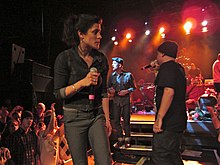

The Walker Art Center, one of the big five modern art museums in the U.S., sits atop Lowry Hill, near downtown. It doubled its size with an addition in 2005 by Herzog & de Meuron and is continuing its expansion to 15 acres (6.1 ha) with a park designed by Michel Desvigne across the street from the Minneapolis Sculpture Garden.[86] The Minneapolis Institute of Arts, designed by McKim, Mead & White in 1915 in south central Minneapolis, is the largest art museum in the city with 100,000 pieces in its permanent collection. New wings designed by Kenzo Tange opened in 1974 and Michael Graves in 2006 for contemporary and modern works and more gallery space.[80] The Weisman Art Museum, designed by Frank Gehry for the University of Minnesota, opened in 1993. An addition which doubled the size of the galleries, also designed by Gehry, opened in 2011.[87] The Museum of Russian Art opened in a restored church in 2005[88] and exhibits a collection of 20th-century Russian art as well as lecture series, seminars, social functions and other special events.
The son of a jazz musician and a singer, Prince is Minneapolis' most famous musical progeny.[89] With fellow local musicians, many of whom recorded at Twin/Tone Records,[90] he helped make First Avenue and the 7th Street Entry venues of choice for both artists and audiences.[91] Other prominent artists from Minneapolis include Hüsker Dü and The Replacements who were pivotal in the U.S. alternative rock boom during the 1990s. The Replacements' frontman, Paul Westerberg, went on to a successful solo career.[92]
The Minnesota Orchestra played classical and popular music at Orchestra Hall under music director Osmo Vänskä who set about making it the best in the country[93]—a critic writing for The New Yorker of a concert in 2010 thought that that day it was "the greatest orchestra in the world".[94] In 2013, the orchestra received a Grammy nomination for its recording of "Sibelius: Symphonies Nos. 2 & 5" and it won the Grammy in 2014 for "Sibelius: Symphonies Nos 1 & 4".[95][96] Vänskä departed in 2013 when a labor dispute remained unresolved and forced cancellation of concerts in Carnegie Hall.[97] After a fifteen month lockout, a contract settlement resulted in the return of the performers to Orchestra Hall in January of 2014. [98]
In 2008, the century-old MacPhail Center for Music opened a new facility designed by James Dayton.[99]
Tom Waits released two songs about the city, "Christmas Card from a Hooker in Minneapolis" (Blue Valentine 1978) and "9th & Hennepin" (Rain Dogs 1985) and Lucinda Williams recorded "Minneapolis" (World Without Tears 2003). Home to the MN Spoken Word Association and independent hip-hop label Rhymesayers Entertainment, the city has garnered notice for rap and hip hop and its spoken word community.[100] The underground hip-hop group Atmosphere (natives of Minnesota) frequently comments in song lyrics on the city and Minnesota.[101]
In 2012, Food & Wine magazine named Minneapolis America's best and best-priced new food city.[102]
Minneapolis is America's third-most literate city.[103] A center for printing and publishing,[104] Minneapolis was a natural place for artists to build Open Book, the largest literary and book arts center in the U.S., made up of the Loft Literary Center, the Minnesota Center for Book Arts and Milkweed Editions, sometimes called the country's largest independent nonprofit literary publisher.[105] The center exhibits and teaches both contemporary art and traditional crafts of writing, papermaking, letterpress printing and bookbinding.[105]
Religion and charity

The Dakota people, the original inhabitants of the area where Minneapolis now stands, believed in the Great Spirit and were surprised that not all European settlers were religious.[107] Over fifty denominations and religions and some well known churches have since been established in Minneapolis. Those who arrived from New England were for the most part Christian Protestants, Quakers, and Universalists.[107] The oldest continuously used church in the city, Our Lady of Lourdes Catholic Church in the Nicollet Island/East Bank neighborhood, was built in 1856 by Universalists and soon afterward was acquired by a French Catholic congregation.[108] The first Jewish congregation in Minneapolis was formed in 1878 as Shaarai Tov (though it has been known[clarification needed] since 1920 as Temple Israel); in 1928, it built the synagogue in East Isles.[48] St. Mary's Orthodox Cathedral was founded in 1887, opened a missionary school in 1897 and in 1905 created the first Russian Orthodox seminary in the U.S.[109] Edwin Hawley Hewitt designed both St. Mark's Episcopal Cathedral and Hennepin Avenue United Methodist Church on Hennepin Avenue just south of downtown.[110] The first basilica in the United States, and Co-Cathedral of the Roman Catholic Archdiocese of Saint Paul and Minneapolis, the Basilica of Saint Mary near Loring Park was named by Pope Pius XI in 1926.[107]
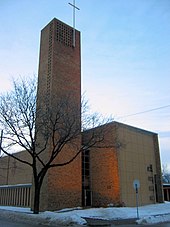
The Billy Graham Evangelistic Association, Decision magazine, and World Wide Pictures film and television distribution were headquartered in Minneapolis for about fifty of the years between the late 1940s into the 2000s.[111] Jim Bakker and Tammy Faye met while attending the Pentecostal North Central University and began a television ministry that by the 1980s reached 13.5 million households.[112] Today, Mount Olivet Lutheran Church in southwest Minneapolis with about 6,000 attendees is the world's largest Lutheran congregation.[113] Christ Church Lutheran in the Longfellow neighborhood is among the finest work by architect Eliel Saarinen. The congregation later added an education building designed by his son Eero Saarinen.[114]
Religions outside the Judeo-Christian mainstream also have a home in the city. During the mid-to-late 1950s, members of the Nation of Islam created a temple in north Minneapolis,[115] and the first mosque was built in 1967.[116] In 1972 a relief agency resettled the first Shi'a Muslim family from Uganda. By 2004, between 20,000 and 30,000 Somali Muslims made the city their home.[117] In 1972, Dainin Katagiri was invited from California to Minneapolis—by one account, a place he thought nobody else would want to go—where he founded a lineage which today includes three Sōtō Zen centers among the city's nearly 20 Buddhist and meditation centers.[118][119] Atheists For Human Rights has its headquarters in the Shingle Creek neighborhood in a geodesic dome.[120] Minneapolis has had a chartered local body of Ordo Templi Orientis since 1994.[121]
Philanthropy and charitable giving are part of the community.[122] More than 40% of adults in the Minneapolis–Saint Paul area give time to volunteer work, the highest such percentage of any large metropolitan area in the United States.[123] Catholic Charities is one of the largest providers of social services locally.[124] The American Refugee Committee helps one million refugees and displaced persons in ten countries in Africa, the Balkans and Asia each year.[125] In 2011, Target Corp. was #42 in a list of the best 100 corporate citizens in CR magazine for corporate responsibility officers.[126] The oldest foundation in Minnesota, the Minneapolis Foundation invests and administers over nine hundred charitable funds and connects donors to nonprofit organizations.[127] The metropolitan area gives 13% of its total charitable donations to the arts and culture. The majority of the estimated $1 billion recent expansion of arts facilities was contributed privately.[128]
Sports
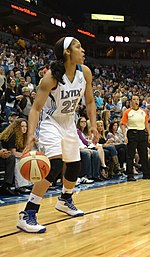
Professional sports are well-established in Minneapolis. First playing in 1884, the Minneapolis Millers baseball team produced the best won-lost record in their league at the time and contributed fifteen players to the Baseball Hall of Fame. During the 1920s, Minneapolis was home to the NFL team the Minneapolis Marines, later known as the Minneapolis Red Jackets.[129] During the 1940s and 1950s the Minneapolis Lakers basketball team, the city's first in the major leagues in any sport, won six basketball championships in three leagues to become the NBA's first dynasty before moving to Los Angeles.[130] The American Wrestling Association, formerly the NWA Minneapolis Boxing & Wrestling Club, operated in Minneapolis from 1960 until the 1990s.[131]
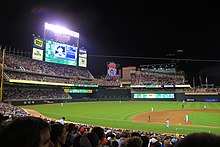
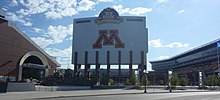
The Minnesota Vikings and the Minnesota Twins arrived in the state in 1961. The Vikings were an NFL expansion team and the Twins were formed when the Washington Senators relocated to Minnesota. Both teams played outdoors in the open air Metropolitan Stadium in the suburb of Bloomington for twenty one years before moving to the Hubert H. Humphrey Metrodome in 1982, where the Twins won the World Series in 1987 and 1991. The Twins moved to Target Field in 2010. The Minnesota Timberwolves brought NBA basketball back to Minneapolis in 1989. They were followed by the Minnesota Lynx WNBA team in 1999. Both basketball teams play in the Target Center. In recent years, the Lynx have been the most successful sports team in Minneapolis and a dominant force in the WNBA, reaching the WNBA Finals in 2011, 2012 and 2013 and winning in 2011 and 2013.[133][134] The Minnesota Wild of the NHL play in St. Paul,[135] and the soccer team Minnesota United FC of the NASL play in Blaine.[136] The Minneapolis Bandolier is the most successful US bandy team of all times, having been crowned United States champions ten times as of 2014.[137][138]
The downtown Metrodome was the largest sports stadium in Minnesota from 1982 to 2013, and the only stadium in the country to have hosted a Major League Baseball All-Star Game, the Super Bowl, the World Series, and the NCAA Basketball Men's Final Four. Demolition started in January 2014 to make way for a new 65,000 seat clear roofed stadium for the Vikings which will open in the fall of 2016.[139]
When the replacement for the Metrodome is built, six spectator sport stadiums will be in a 1.2-mile (2 km) radius centered downtown, counting the existing facilities at Target Center and the university's Williams Arena and Mariucci Arena.[140] The new Target Field is funded by the Twins and 75% by Hennepin County sales tax, about $25 per year by each taxpayer.[141] The Gopher football program's new TCF Bank Stadium was built by the university and the state's general fund.[141]
Major sporting events hosted by the city include the 1985 Major League Baseball All-Star Game, the 1987 and 1991 World Series, Super Bowl XXVI, the 1992 NCAA Men's Division I Final Four, the 2001 NCAA Men's Division 1 Final Four and the 1998 World Figure Skating Championships.[142][143][144] Minneapolis has made it to the international round finals to host the Summer Olympic games three times, being beaten by London in 1948, Helsinki in 1952 (when the city finished in second place), and Melbourne in 1956.
Gifted amateur athletes have played in Minneapolis schools, notably starting in the 1920s and 1930s at Central, DeLaSalle, and Marshall high schools.[130] Since the 1930s, the Golden Gophers have won national championships in baseball, boxing, football, golf, gymnastics, ice hockey, indoor and outdoor track, swimming, and wrestling.[145]
| Professional Sports in Minneapolis | ||||
|---|---|---|---|---|
| Club | Sport | League | Venue | Championships |
| Minnesota Lynx | Basketball | WNBA | Target Center | WNBA Finals 2011 and 2013 |
| Minnesota Timberwolves | Basketball | NBA | Target Center | |
| Minnesota Twins | Baseball | MLB | Target Field | World Series 1987 and 1991 |
| Minnesota Vikings | American Football | NFL | TCF Bank Stadium | 1969 NFL Championship |
Parks and recreation
The Minneapolis park system has been called the best-designed, best-financed, and best-maintained in America.[148] Foresight, donations and effort by community leaders enabled Horace Cleveland to create his finest landscape architecture, preserving geographical landmarks and linking them with boulevards and parkways.[149] The city's Chain of Lakes, consisting of seven lakes and Minnehaha Creek, is connected by bike, running, and walking paths and used for swimming, fishing, picnics, boating, and ice skating. A parkway for cars, a bikeway for riders, and a walkway for pedestrians runs parallel along the 52 miles (84 km) route of the Grand Rounds Scenic Byway.[150]
Theodore Wirth is credited with the development of the parks system.[151] Today, 16.6% of the city is parks and there are 770 square feet (72 m2) of parkland for each resident, ranked in 2008 as the most parkland per resident within cities of similar population densities.[152][153] In its 2013 ParkScore ranking, The Trust for Public Land reported that Minneapolis had the best park system among the 50 most populous U.S. cities.[154][155]
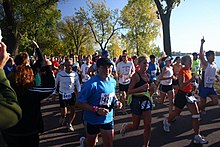
Parks are interlinked in many places and the Mississippi National River and Recreation Area connects regional parks and visitor centers. The country's oldest public wildflower garden, the Eloise Butler Wildflower Garden and Bird Sanctuary, is located within Theodore Wirth Park. Wirth Park is shared with Golden Valley and is about 60% the size of Central Park in New York City.[156] Site of the 53-foot (16 m) Minnehaha Falls, Minnehaha Park is one of the city's oldest and most popular parks, receiving over 500,000 visitors each year.[147] Henry Wadsworth Longfellow named Hiawatha's wife Minnehaha for the Minneapolis waterfall in The Song of Hiawatha, a bestselling and often-parodied 19th century poem.[157]
Runner's World ranks the Twin Cities as America's sixth best city for runners.[158] Team Ortho sponsors the Minneapolis Marathon, Half Marathon and 5K which began in 2009 with more than 1,500 starters.[159][160] The Twin Cities Marathon run in Minneapolis and Saint Paul every October draws 250,000 spectators. The 26.2-mile (42.2 km) race is a Boston and USA Olympic Trials qualifier. The organizers sponsor three more races: a Kids Marathon, a 1-mile (1.6 km), and a 10-mile (16 km).[161]
The American College of Sports Medicine ranked Minneapolis (with Saint Paul) the "fittest city" in the U.S. each year from 2011 through 2013.[162] In other sports, five golf courses are located within the city, with nationally ranked Hazeltine National Golf Club, and Interlachen Country Club in nearby suburbs.[163] Minneapolis is home to more golfers per capita than any other major U.S. city.[164] The state of Minnesota has the nation's highest number of bicyclists, sport fishermen, and snow skiers per capita. Hennepin County has the second-highest number of horses per capita in the U.S.[77] While living in Minneapolis, Scott and Brennan Olson founded (and later sold) Rollerblade, the company that popularized the sport of inline skating.[165]
Government
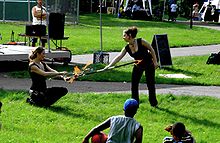
Minneapolis is a stronghold for the Minnesota Democratic-Farmer-Labor Party (DFL), an affiliate of the Democratic Party. The Minneapolis City Council holds the most power and represents the city's thirteen districts called wards. The city adopted ranked choice voting in 2006, first using it in the 2009 elections.[166] The council has 12 DFL members and one from the Green Party.[citation needed] Election issues in 2013 included funding for a new Vikings Stadium over which some incumbents lost their positions.[166] That year, Minneapolis elected Abdi Warsame, Alondra Cano, and Blong Yang, the city's first Somali-American, Mexican-American, and Hmong-American city councilpeople, respectively.[166][167][168]
Betsy Hodges of the DFL is the current mayor of Minneapolis.[167] The office of mayor is relatively weak but has some power to appoint individuals such as the chief of police. Parks, taxation, and public housing are semi-independent boards and levy their own taxes and fees subject to Board of Estimate and Taxation limits.[169]
At the federal level, Minneapolis proper sits within Minnesota's 5th congressional district, which has been represented since 2006 by Democrat Keith Ellison, the first practicing Muslim in the United States Congress. Both of Minnesota's two U.S. Senators, Amy Klobuchar and Al Franken, were also elected while living in Minneapolis and are also Democrats.[170]
The Republican Party of Minnesota in January 2014 moved its state headquarters from Saint Paul to the Seward neighborhood of Minneapolis.[171]
Citizens had a unique and powerful influence in neighborhood government. Neighborhoods coordinated activities under the Neighborhood Revitalization Program (NRP), which ended in 2009.[172] Minneapolis is divided into communities, each containing neighborhoods. In some cases two or more neighborhoods act together under one organization. Some areas are commonly known by nicknames of business associations.[173]
The organizers of Earth Day scored Minneapolis ninth best overall and second among mid-sized cities in their 2007 Urban Environment Report, a study based on indicators of environmental health and their effect on people.[174]
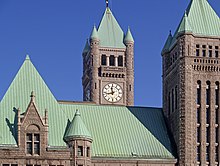
Early Minneapolis experienced a period of corruption in local government and crime was common until an economic downturn in the mid-1900s. Since 1950 the population decreased and much of downtown was lost to urban renewal and highway construction. The result was a "moribund and peaceful" environment until the 1990s.[175] Along with economic recovery the murder rate climbed. The Minneapolis Police Department imported a computer system from New York City that sent officers to high crime areas. Despite accusations of racial profiling; the result was a drop in major crime. Since 1999 the number of homicides increased during four years.[176] Politicians debated the causes and solutions, including increasing the number of police officers, providing youths with alternatives to gangs and drugs, and helping families in poverty.[177]
From 2006 to 2012, under chief Tim Dolan, the crime rate steadily dropped, and the police benefited from new video and gunfire locator resources, although Dolan was criticized for expensive city settlements for police misconduct.[178] While violent crime dropped (from 6,374 in 2006 to 3,720 in 2011[178]), homicides rose by 105%[179] and rape was at the highest rate among large cities.[180] U.S. News & World Report said in 2011 that Minneapolis tied with Cleveland, Ohio as the 10th most dangerous city in the United States.[181]
Janeé Harteau was confirmed as the new chief in 2012. A member of the force since 1987, Harteau, who was nominated by mayor R.T. Rybak and is the city's first female and first openly gay police chief, already served as deputy chief, inspector, and patrol bureau commander.[182][183]
Education
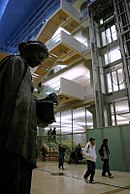
Minneapolis Public Schools enroll 36,370 students in public primary and secondary schools. The district administers about 100 public schools including 45 elementary schools, seven middle schools, seven high schools, eight special education schools, eight alternative schools, 19 contract alternative schools, and five charter schools. With authority granted by the state legislature, the school board makes policy, selects the superintendent, and oversees the district's budget, curriculum, personnel, and facilities. Students speak 90 different languages at home and most school communications are printed in English, Hmong, Spanish, and Somali.[184] About 44% of students in the Minneapolis Public School system graduate, which ranks the city the 6th worst out of the nation's 50 largest cities.[185] Some students attend public schools in other school districts chosen by their families under Minnesota's open enrollment statute.[186] Besides public schools, the city is home to more than 20 private schools and academies and about 20 additional charter schools.[187]
Minneapolis' collegiate scene is dominated by the main campus of the University of Minnesota where more than 50,000 undergraduate, graduate, and professional students attend 20 colleges, schools, and institutes.[188] The graduate school programs ranked highest in 2007 were counseling and personnel services, chemical engineering, psychology, macroeconomics, applied mathematics and non-profit management.[189] A Big Ten school and home of the Golden Gophers, the U of M is the fourth largest campus among U.S. public 4-year universities in terms of enrollment.[190]
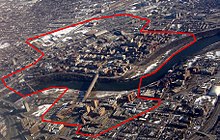
Augsburg College, Minneapolis College of Art and Design, and North Central University are private four-year colleges. Minneapolis Community and Technical College, the private Dunwoody College of Technology, Globe University/Minnesota School of Business, and Art Institutes International Minnesota provide career training. St. Mary's University of Minnesota has a Twin Cities campus for its graduate and professional programs. Capella University, Minnesota School of Professional Psychology, and Walden University are headquartered in Minneapolis and some others including the public four-year Metropolitan State University and the private four-year University of St. Thomas have campuses there.[191]
The Hennepin County Library system began to operate the city's public libraries in 2008.[192] The Minneapolis Public Library, founded by T. B. Walker in 1885,[193] faced a severe budget shortfall for 2007, and was forced to temporarily close three of its neighborhood libraries.[194] The new downtown Central Library designed by César Pelli opened in 2006.[195] Ten special collections hold over 25,000 books and resources for researchers, including the Minneapolis Collection and the Minneapolis Photo Collection.[196] At recent count 1,696,453 items in the system are used annually and the library answers over 500,000 research and fact-finding questions each year.[197]
Media
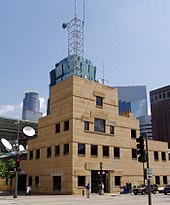
Five major newspapers are published in Minneapolis: Star Tribune, Finance and Commerce, Minnesota Spokesman-Recorder, the university's The Minnesota Daily and MinnPost.com. Other publications are the City Pages weekly, the Mpls.St.Paul and Minnesota Monthly monthlies, and Utne magazine.[198] In 2008 readers of online news also used The UpTake, Minnesota Independent, Twin Cities Daily Planet, Downtown Journal, Cursor, MNSpeak and about fifteen other sites.[199]
Minneapolis has a mix of radio stations and healthy listener support for public radio but in the commercial market, a single organization, Clear Channel Communications, operates seven stations and a translator. Listeners support three Minnesota Public Radio non-profit stations and two community non-profit stations, the Minneapolis Public Schools and the University of Minnesota each operate a station, and religious organizations run four stations.[200]
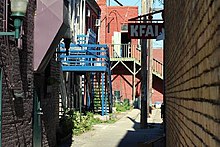
The city's first television was broadcast by the Saint Paul station and ABC affiliate KSTP-TV. The first to broadcast in color was WCCO-TV, the CBS affiliate which is located in downtown Minneapolis.[201] The city and suburbs are also home to affiliates of FOX, NBC, PBS, MyNetworkTV, The CW and one independent station.[202]
A statue of Mary Tyler Moore is located downtown on the Nicollet Mall which commemorates the legendary 1970s CBS television situation comedy fictionally based in Minneapolis, The Mary Tyler Moore Show. It marks the nearby site where, in the series' iconic opening sequence, character Mary Richards, played by Moore, throws her hat in the air. The show was awarded three Golden Globes and 31 Emmy Awards.[203] Twins Brandon and Brenda Walsh were from Minneapolis on the TV series Beverly Hills, 90210.[204] American Idol held auditions for its sixth season in Minneapolis in 2006[205] and Last Comic Standing held auditions for its fifth season in Minneapolis in 2007.[206] In Young Adult, a 2011 screenplay by Diablo Cody, Charlize Theron lived in a Churchill riverfront apartment.[207]
Infrastructure
Transportation
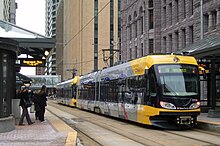
Half of Minneapolis–Saint Paul residents work in the city where they live.[208] Most residents drive cars but 60% of the 160,000 people working downtown commute by means other than a single person per auto.[209] Alternative transportation is encouraged. The Metropolitan Council's Metro Transit, which operates the light rail system and most of the city's buses, provides free travel vouchers through the Guaranteed Ride Home program to allay fears that commuters might otherwise be occasionally stranded if, for example, they work late hours.[210]
On January 1, 2011, the city's limit of 343 taxis was lifted.[211]
Minneapolis currently has one light rail and one commuter rail line. The METRO Blue Line LRT (formerly the Hiawatha Line[212]) serves 34,000 riders daily and connects the Minneapolis–Saint Paul International airport and Mall of America in Bloomington to downtown. Most of the line runs at surface level, although parts of the line run on elevated tracks (including the Franklin Ave. and Lake St./Midtown stations) and approximately 2 miles (3.2 km) of the line runs underground, including the Lindbergh terminal subway station at the airport. The 40-mile Northstar Commuter rail, which runs from Big Lake through the northern suburbs and terminates at the multi-modal transit station at Target Field, opened on November 16, 2009.[213] It utilizes existing railroad tracks and serves 2,600 daily commuters.[214]
Minneapolis' second light rail line, the METRO Green Line will share stations with the Blue Line in downtown Minneapolis, and then at the Downtown East/Metrodome station, travel east through the University of Minnesota, and then along University Avenue into downtown Saint Paul. Construction began in November 2010 and expected to open in early 2014. The third line, the Southwest Line (Green Line extension), will connect downtown Minneapolis with the southwestern suburb of Eden Prairie. Completion is expected in 2017.[215] A northwest LRT is planned for along Bottineau Boulevard (Blue Line extension) from downtown to Brooklyn Park and Maple Grove.
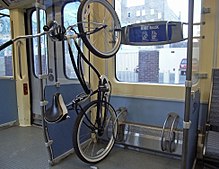
Minneapolis ranks 27th in the nation for the highest percentage of commuters by bicycle,[216] and was editorialized as the top bicycling city in "Bicycling's Top 50" ranking in 2010.[217] Ten thousand cyclists use the bike lanes in the city each day, and many ride in the winter. The Public Works Department expanded the bicycle trail system from the Grand Rounds to 56 miles (90 km) of off-street commuter trails including the Midtown Greenway, the Light Rail Trail, Kenilworth Trail, Cedar Lake Trail and the West River Parkway Trail along the Mississippi. Minneapolis also has 34 miles (54 km) of dedicated bike lanes on city streets and encourages cycling by equipping transit buses with bike racks and by providing online bicycle maps.[218] Many of these trails and bridges, such as the Stone Arch Bridge, were former railroad lines that have now been converted for bicycles and pedestrians.[219] In 2007 citing the city's bicycle lanes, buses and LRT, Forbes identified Minneapolis the world's fifth cleanest city.[220] In 2010, Nice Ride Minnesota launched with 65 kiosks for bicycle sharing,[221] and 19 pedicabs were operating downtown.[222] Nice Ride plans to expand in 2013 to 170 stations in Minneapolis and Saint Paul, and expects to add 17 more in 2014.[223]
A 2011 study by Walk Score ranked Minneapolis the ninth most walkable of 50 largest cities in the United States.[224]
Seven miles (11 km) of enclosed pedestrian bridges called skyways, the Minneapolis Skyway System, link eighty city blocks downtown. Second floor restaurants and retailers connected to these passageways are open on weekdays.[225]
Minneapolis–Saint Paul International Airport (MSP) sits on 3,400 acres (1,400 ha)[226] on the southeast border of the city between Minnesota State Highway 5, Interstate 494, Minnesota State Highway 77, and Minnesota State Highway 62. The airport serves three international, 12 domestic, seven charter and four regional carriers[227] and is a hub and home base for Delta Air Lines, Mesaba Airlines, and Sun Country Airlines.[228]
Health and utilities
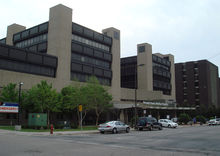
Minneapolis has seven hospitals, four ranked among America's best by U.S. News & World Report—Abbott Northwestern Hospital (part of Allina), Children's Hospitals and Clinics, Hennepin County Medical Center (HCMC) and the University of Minnesota Medical Center, Fairview.[229] Minneapolis VA Medical Center, Shriners Hospitals for Children and Allina's Phillips Eye Institute also serve the city.[230] The Mayo Clinic in Rochester, Minnesota is a 75-minute drive away.[231]
Cardiac surgery was developed at the university's Variety Club Hospital, where by 1957, more than 200 patients had survived open-heart operations, many of them children. Working with surgeon C. Walton Lillehei, Medtronic began to build portable and implantable cardiac pacemakers about this time.[232]
HCMC opened in 1887 as City Hospital and was also known as General Hospital.[28] A public teaching hospital and Level I trauma center, the HCMC safety net sees more than 350,000 clinic visits and 97,000 emergency room visits each year and in 2012 provided about 18% of the uncompensated care given in Minnesota.[233]
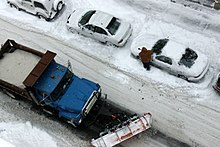
Funded in part by assessments on commercial properties, in 2009 Ambassadors of the Minneapolis Downtown Improvement District (DID) began working on 120 blocks of downtown to improve its cleanliness, friendliness and acceptability of behavior. They are employees of Block by Block, a company in Nashville, Tennessee that serves 46 U.S. cities.[234]
Utility providers are regulated monopolies: Xcel Energy supplies electricity, CenterPoint Energy supplies gas, CenturyLink provides landline telephone service, and Comcast provides cable service.[235] In 2007 citywide wireless internet coverage began, provided for 10 years by US Internet of Minnetonka to residents for about $20 per month and to businesses for $30.[236] The Minneapolis Wi-Fi network earns $1.2 million annual profit and as of 2010 has about 20,000 customers.[237] The city treats and distributes water and requires payment of a monthly solid waste fee for trash removal, recycling, and drop off for large items. Residents who recycle receive a credit. Hazardous waste is handled by Hennepin County drop off sites.[235] After each significant snowfall, called a snow emergency, the Minneapolis Public Works Street Division plows over 1,000 miles (1,609 km) of streets and 400 miles (643.7 km) of alleys—counting both sides, the distance between Minneapolis and Seattle and back. Ordinances govern parking on the plowing routes during these emergencies as well as snow shoveling throughout the city.[238]
Notable people
Sister cities
As shown below Minneapolis has 10 sister cities:[239][240]
 Najaf (Iraq) since 2009
Najaf (Iraq) since 2009 Cuernavaca (Mexico) since 2008
Cuernavaca (Mexico) since 2008 Uppsala (Sweden) since 2000
Uppsala (Sweden) since 2000 Eldoret (Kenya) since 2000
Eldoret (Kenya) since 2000 Harbin (PR China) since 1992
Harbin (PR China) since 1992 Tours (France) since 1991
Tours (France) since 1991 Novosibirsk (Russia) since 1988
Novosibirsk (Russia) since 1988 Ibaraki (Japan) since 1980
Ibaraki (Japan) since 1980 Kuopio (Finland) since 1972
Kuopio (Finland) since 1972 Santiago (Chile) since 1961
Santiago (Chile) since 1961
And informal connections with ![]() Hiroshima, Japan
Hiroshima, Japan
According to Winnipeg, Minneapolis once was sister cities with ![]() Winnipeg, Canada.[241]
Winnipeg, Canada.[241]
See also
- Minneapolis – Saint Paul
- Northeast Minneapolis
- List of events and attractions in Minneapolis
- List of tallest buildings in Minneapolis
- National Register of Historic Places listings in Hennepin County, Minnesota
References
- ^ "Annual Estimates of the Resident Population for Incorporated Places over 100,000, Ranked by July 1, 2009 Population: April 1, 2000 to July 1, 2009 (SUB-EST2009-01)". United States Census Bureau, Population Division. September 2010. Archived from the original (XLS) on September 20, 2010. Retrieved October 15, 2010.
- ^ "Population Estimates". United States Census Bureau. Retrieved 2013-05-28.
- ^ "Minneapolis (city) QuickFacts From the U.S. Census Bureau". US Census Bureau. 18 September 2012. Retrieved 7 November 2012.
- ^ "GCT-PL2: Population and Housing Occupancy Status: 2010 – United States – Metropolitan Statistical Area; and for Puerto Rico more information 2010 Census National Summary File of Redistricting Data". American FactFinder. U.S. Census Bureau. Retrieved October 28, 2011.
- ^ a b "Minneapolis". Emporis Buildings (emporis.com). Retrieved 2007-03-18.
- ^ "Cities". Fortune 500. CNN Money. Retrieved 7 February 2012.
- ^ "The World According to GaWC". GaWC.
- ^ Bright, William (2004). Native American Placenames of the United States. University of Oklahoma Press via Google Books. p. 286. ISBN 978-0-8061-3598-4.
- ^ Collections of the Minnesota Historical Society. Vol. X Part 1. Minnesota Historical Society via Google Books. 1905. p. 262. Retrieved September 4, 2012.
- ^ Kappler, Charles J., Washington: Government Printing Office, ed. (1904). Indian Affairs: Laws and Treaties. Vol. II (Treaties, 1778–1883). Oklahoma State University Library.
{{cite book}}: CS1 maint: multiple names: editors list (link). and "Treaty with the Sioux". 1837-09-29. and "Treaty with the Sioux—Sisseton and Wahpeton Bands". 1851-07-23. and "Treaty With the Sioux—Mdewakanton and Wapahkoota Bands". 1851-08-05. Retrieved 2007-06-26. - ^ a b "A History of Minneapolis: Mdewakanton Band of the Dakota Nation, Parts I and II". Hennepin County Library. 2001. and "A History of Minneapolis: Minneapolis Becomes Part of the United States"., and "A History of Minneapolis: Governance and Infrastructure". and "A History of Minneapolis: Railways". Retrieved October 17, 2012.
- ^ Frame, Robert M. III, Jeffrey Hess (January 1990). "West Side Milling District, Historic American Engineering Record MN-16". U.S. National Park Service (via U.S. Library of Congress). p. 2. Retrieved 2007-04-16.
{{cite web}}: CS1 maint: multiple names: authors list (link) - ^ Hart, Joseph (June 11, 1997). "Lost City". City Pages. Village Voice Media. Retrieved October 28, 2013.
- ^ "History of Technology". HistoryWorld (historyworld.net). Retrieved 2007-04-04.
- ^ Anfinson, Scott F. (1989). "Part 2: Archaeological Explorations and Interpretive Potentials: Chapter 4 Interpretive Potentials". The Minnesota Archaeologist. 49. The Institute for Minnesota Archaeology. Retrieved 2007-04-03.
- ^ a b c Watts, Alison (Summer 2000). "The technology that launched a city: scientific and technological innovations in flour milling during the 1870s in Minneapolis" (PDF). Minnesota History. Minnesota Historical Society: 86–97.
- ^ a b c d e f Danbom, David B. (2003). "Flour power: the significance of flour milling at the falls" (PDF). Minnesota History. 58 (5–6). Minnesota Historical Society: 270–285. Retrieved October 29, 2013.
- ^ "Crown Roller Mill: HAER No. MN-12". Historic American Buildings Survey/Historic American Engineering Record. U.S. Library of Congress. p. 10. Retrieved October 31, 2013.
- ^ "History". Mill City Museum. Archived from the original on May 13, 2007. Retrieved 2007-04-04.
{{cite web}}: Unknown parameter|deadurl=ignored (|url-status=suggested) (help) - ^ Nathanson, Iric (2010). Minneapolis In the Twentieth Century: The Growth of an American City. Minnesota Historical Society Press. pp. 41–47. ISBN 0-87351-725-3.
- ^ Nathanson, Iric (2010). Minneapolis In the Twentieth Century: The Growth of an American City. Minnesota Historical Society Press. p. 58. ISBN 0-87351-725-3.
- ^ Atwater, Isaac (1893). History of the City of Minneapolis, Minnesota. Munsell (via Google Books). pp. 257–262. Retrieved 2007-04-23.
- ^ "1934 Truckers' Strike (Minneapolis)". Minnesota Historical Society. Retrieved 2007-05-05.
- ^ Reichard, Gary W. (Summer 1998). "Mayor Hubert H. Humphrey". Minnesota History. 56 (2). Minnesota Historical Society: 50–67. Archived from the original on 2007-09-29. Retrieved 2007-05-06.
- ^ "Historical Census Statistics On Population Totals By Race, 1790 to 1990, and By Hispanic Origin, 1970 to 1990, For Large Cities And Other Urban Places In The United States". U.S. Census Bureau. Retrieved 2011-12-18.
- ^ Harry Davis (February 21, 2003). Almanac. Twin Cities Public Television. and "American Indian Movement". Encyclopaedia Britannica. 2012. Retrieved 2012-08-19.
- ^ Weber, Laura E. (Spring 1991). "Gentiles Preferred" (PDF). Minnesota History. Minnesota Historical Society: 167, 172, 182. Retrieved August 21, 2012.
- ^ a b "A History of Minneapolis: Medicine". Hennepin County Library. 2001. Retrieved October 17, 2012.
- ^ Hart, Joseph (1998-05-06). "Room at the Bottom". City Pages. 19 (909). Village Voice Media. Retrieved 2007-04-01.
- ^ "Water Resources Report" (PDF). Minneapolis Park & Recreation Board. 2003. Retrieved 2007-08-07.
- ^ "Mississippi: River Facts". U.S. National Park Service. 2006-08-14. Archived from the original on October 12, 2007.
{{cite web}}: Unknown parameter|deadurl=ignored (|url-status=suggested) (help) and "Police Recruiting: About Minneapolis". City of Minneapolis. 2006. Archived from the original on October 12, 2007. Retrieved 2007-04-29.{{cite web}}: Unknown parameter|deadurl=ignored (|url-status=suggested) (help) - ^ "Minneapolis". Encarta. 1993–2007. Archived from the original on 2007-04-17. and "Minnesota—Place and County Subdivision". U.S. Census Bureau. 2000. Retrieved 2007-03-24.
{{cite web}}: Unknown parameter|deadurl=ignored (|url-status=suggested) (help)[dead link] - ^ a b "State of the City: Physical Environment" (PDF). Minneapolis Planning Division via Internet Archive. 2003. Archived from the original (PDF) on 2009-02-06. Retrieved 2013-03-04.
- ^ "The 45th Parallel". Wurlington Bros. Press. Archived from the original on 2006-11-25. Retrieved 2007-01-18.
- ^ "Minnesota Preservation Planner IX (2)" (PDF). Minnesota Historical Society. Spring 1998. Retrieved 2007-03-21. and Bonham, Tim (June 10, 2001). "email". Retrieved 2007-01-12. and "Elevations and Distances in the United States". U.S. Department of the Interior — U.S. Geological Survey. April 29, 2005. Retrieved 2007-04-11.[dead link]
- ^ Normals, Means, and Extremes for Minneapolis/Saint Paul (1971–2000): Mean of Extreme Mins for January
- ^ Fisk, Charles (February 11, 2011). "Graphical Climatology of Minneapolis-Saint Paul Area Temperatures, Precipitation, and Snowfall". Retrieved 2011-02-18.
- ^ United States Census Bureau. "Census of Population and Housing". Retrieved June 15, 2013.
- ^ "Annual Estimates of the Resident Population: April 1, 2010 to July 1, 2012". Retrieved June 15, 2013.
- ^ "Race for the Population 18 Years and Over". U.S. Census Bureau: American FactFinder. 2010. Retrieved March 20, 2011.
- ^ "American FactFinder". Factfinder2.census.gov. 2010-10-05. Retrieved 2011-09-04.
- ^ "Hispanic or Latino, and Not Hispanic or Latino By Race for the Population 18 Years and Over". U.S. Census Bureau: American FactFinder. 2010. Retrieved March 20, 2011.
- ^ American FactFinder, United States Census Bureau. "Minneapolis city, Minnesota — Selected Social Characteristics in the United States: 2006–2008". Factfinder.census.gov. Retrieved 2011-09-03.[dead link]
- ^ "Minneapolis (city), Minnesota". State & County QuickFacts. U.S. Census Bureau. Retrieved April 21, 2012.
- ^ "Race and Hispanic Origin for Selected Cities and Other Places: Earliest Census to 1990". U.S. Census Bureau. Retrieved April 21, 2012.
- ^ American FactFinder, United States Census Bureau. "Minneapolis city, Minnesota — ACS Demographic and Housing Estimates: 2006–2008". Factfinder.census.gov. Retrieved 2011-09-03.[dead link]
- ^ GR Anderson Jr (October 1, 2003). "Living in America". City Pages. Retrieved 2008-04-29.
- ^ a b Nathanson, Iric. "Jews in Minnesota" (PDF). Jewish Community Relations Council. Archived from the original (PDF) on 2007-06-15. Retrieved 2007-04-14.[dead link]
- ^ "A History of Minneapolis: 20th Century Growth and Diversity". Hennepin County Library. 2001. Retrieved October 17, 2012.
- ^ a b "Minneapolis/Saint Paul in Focus: A Profile from Census 2000". Metropolitan Policy Program, The Brookings Institution. November 2003. Retrieved 2008-04-29.
- ^ "12.9% in Seattle are gay or bisexual, second only to S.F., study says". The Seattle Times. 2006. Retrieved 2009-03-20.
- ^ Gates, Gary J. (October 2006). "Same-sex Couples and the Gay, Lesbian, Bisexual Population: New Estimates from the American Community Survey" (PDF). Williams Institute, UCLA School of Law, University of California, Los Angeles. Retrieved 2008-02-26.
- ^ Breen, Matthew (January 9, 2012). "Gayest Cities in America". The Advocate. Here Media. Retrieved 2012-01-10.
- ^ Kimball, Joe (November 19, 2013). "LGBT support: Minneapolis and St. Paul rank high in national assessment". MinnPost. Retrieved November 21, 2013.
- ^ "Minneapolis—Saint Paul, MN—WI: Summary Profile". Harvard University. 2007. Archived from the original on 2007-09-24. Retrieved 2008-04-29.
- ^ "Key Facts — Trouble at the Core Update". Metropolitan Council. 2007-11-07. Retrieved 2008-04-29.[dead link]
- ^ Gibson, Campbell (June 1998). "Table 1. Rank by Population of the 100 Largest Urban Places, Listed Alphabetically by State: 1790–1990". U.S. Census Bureau. Archived from the original on 2007-05-13. Retrieved 2007-05-01.
- ^ Atwater, Isaac (1893). History of the city of Minneapolis, Minnesota. Munsell via Google Books.
- ^ "Minneapolis: The contemporary city". Encyclopaedia Britannica. 2007. Retrieved 2007-03-24.
- ^ Shutter, D.D., LL.D., Rev. Marion Daniel, ed. (1923). History of Minneapolis, Gateway to the Northwest. Vol. I. The S J Clarke Publishing Co via The USGenWeb Project.
{{cite book}}: CS1 maint: multiple names: editors list (link) - ^ "Fortune 500: Minnesota". Fortune. 2012. Retrieved September 2, 2012.
{{cite news}}: Italic or bold markup not allowed in:|publisher=(help) - ^ John Vomhof Jr. (February 17, 2012). "List Leaders: Largest Downtown Minneapolis employers". Minneapolis / St. Paul Business Journal. Retrieved September 2, 2012.
- ^ "Largest Employers — Top 25". Twin Cities Business. MSP Communications. 2009. Retrieved September 2, 2012.
- ^ "All Locations". and "Corporate Fact Sheet". and "Corporate Overview". Target. Retrieved September 18, 2013.
- ^ "Saint Paul — Governor Tim Pawlenty announced today that Coloplast will move its North American corporate headquarters to Minnesota beginning this fall" (Press release). Coloplast Group. May 7, 2006. Retrieved January 20, 2010.[dead link]
- ^ "Our Company". RBC Wealth Management. Retrieved January 20, 2010.[dead link]
- ^ "Locations (Affiliates)". ING North America Insurance. Retrieved January 20, 2010.
- ^ Pacella, Rena Marie (2005). "Top Tech City: Minneapolis, MN". Popular Science. Retrieved 2007-01-18.[dead link]
- ^ Jane Bennett Clark (October 2005). "Seven Cool Cities". Kiplinger's Personal Finance. The Kiplinger Washington Editors, Inc. Retrieved 2007-02-11.[dead link] and "50 Smart Places to Live: #2 Minneapolis-Saint Paul, Minn". The Kiplinger Washington Editors, Inc. (Kiplinger.com). June 1, 2006. Retrieved 2007-02-11.
- ^ "Gross Metropolitan Product". Greyhill Advisors. Retrieved 7 October 2011.
- ^ "The Role of Metro Areas in the U.S. Economy" (PDF). Global Insight. 2006. Retrieved 2007-02-12. and "Personal Income and Per Capita Personal Income by Metropolitan Area, 2003–2005". Bureau of Economic Analysis. September 6, 2006. Retrieved 2007-02-12.
- ^ Levy, David (December 1992). "Interview with Paul Volcker". The Region. and "Federal Reserve Bank of Minneapolis". Retrieved 2007-04-30.
- ^ "Buyers & Processors". North Dakota Wheat Commission. Retrieved 2007-04-02.
- ^ DeRusha, Jason (January 19, 2011). "Good Question: Why Did Somalis Locate Here?". CBS Local. CBS Radio. Retrieved January 14, 2012.
- ^ Nocera, Joe (December 22, 2007). "The capital of corporate philanthropy". International Herald Tribune. The New York Times Company. Archived from the original on May 8, 2008. Retrieved 2008-01-11.
{{cite news}}: Unknown parameter|deadurl=ignored (|url-status=suggested) (help) and "A History of Minneapolis: Social Services". Hennepin County Library. 2001. Retrieved October 17, 2012. - ^ "Explore the Collection". and "Visit the Museum / Hours & Location". Minneapolis Institute of Arts. Retrieved February 18, 2012.
- ^ a b "Newspapers: Star Tribune". The McClatchy Company. Retrieved 2007-02-11.
- ^ Horwich, Jeff (April 6, 2005). "Council moves closer to theater deal, but concerns remain". Minnesota Public Radio. Retrieved 2007-03-21. and "Music & Theater". City of Minneapolis. Retrieved 2007-02-12.
- ^ "Minnesota Fringe Festivl" (PDF). Minnesota Fringe Festival. Retrieved 2008-07-20.
- ^ a b Joubert, Claire (May 2006). "Boom Town" (PDF). Mpls.St.Paul (via Meet Minneapolis). Archived from the original (PDF) on 2007-06-15. Retrieved 2007-03-21.
- ^ "Guthrie Theatre". Minnesota Historical Society. and "Theater History". Guthrie Theater. Retrieved 2007-04-23.
- ^ "Theatre History". Hennepin Theatre Trust. Retrieved 2007-03-17.
- ^ Preston, Rohan (September 8, 2011). "Cowles Center: Big leap for Twin Cities arts". Star Tribune. Retrieved September 9, 2011.
- ^ LeFevre, Camille (June 30, 2010). "Shubert renamed Cowles Center for Dance and Performing Arts". MinnPost. Retrieved August 21, 2010.
- ^ Palmer, Caroline (2000-04-26). "Footsteps". City Pages. 21 (1012). Village Voice Media. and Minneapolis Arts Commission; et al. (June 2005). "The Minneapolis Plan for Arts & Culture" (PDF). City of Minneapolis. Retrieved 2007-06-29.
{{cite web}}: Explicit use of et al. in:|author=(help) - ^ "Minneapolis Sculpture Garden". Retrieved 2007-03-18.
- ^ Kerr, Euan (October 2, 2011). "Weisman celebrates reopening with its designer in attendance". Minnesota Public Radio. Retrieved January 14, 2012.
- ^ "History: TMORA".
- ^ Matos, Michaelangelo in Brackett, Nathan (2004-11-02). The New Rolling Stone Album Guide (4 ed.). Fireside. p. 64. ISBN 978-0-7432-0169-8. Archived from the original on April 20, 2007. Retrieved 2007-04-30.
{{cite book}}: Unknown parameter|deadurl=ignored (|url-status=suggested) (help)CS1 maint: multiple names: authors list (link) - ^ "The Twin/Tone catalog". Twin/Tone Records. 1978–1998. Retrieved 2007-01-15.
- ^ "First Avenue & 7th Street Entry Band Files". Minnesota Historical Society. 1999–2004. Archived from the original on 2007-02-10. Retrieved 2007-02-12.
- ^ Azerrad, Michael (2002). Our Band Could Be Your Life. Back Bay Books. p. 5. ISBN 978-0-316-78753-6.
- ^ Oestreich, James R. (December 17, 2006). "MUSIC; A Most Audacious Dare Reverberates". The New York Times. The New York Times Company. Retrieved 2008-04-06.
- ^ Ross, Alex (March 22, 2010). "Battle of the Bands". The New Yorker. Retrieved March 27, 2010.
- ^ Espeland, Pamela (December 7, 2012). "Five Grammy nominations have Minneapolis ties; more holiday shows". MinnPost. Retrieved January 10, 2013.
- ^ Bream, Jon (January 27, 2014). "Minnesota Orchestra and Osmo Vänskä score a Grammy". Star Tribune. Retrieved March 14, 2014.
- ^ Royce, Graydon (October 3, 2013). "Osmo Vänskä's departure shakes Minnesota Orchestra". Star Tribune. Retrieved January 3, 2014.
- ^ name=Royce>Royce, Graydon (January 15, 2014). "Jan. 15: Three-year Minnesota Orchestra deal ends 15-month lockout". Star Tribune. Retrieved January 3, 2014.
- ^ Mack, Linda (January 10, 2008). "MacPhail: a new note for the Minneapolis riverfront". MinnPost. Retrieved 2008-01-10.
- ^ "Minnesota Spoken Word Association". Retrieved 2007-03-18.
- ^ Atmosphere (January 4, 2005). "I Wish Those Cats @ Fobia Would Give Me Some Free Shoes" and "Sep Seven Game Show Them" and "7th St. Entry" on Headshots: SE7EN remastered. Rhymesayers, ASIN: B0006SSRXS [Explicit lyrics].
- ^ Krader, Katy (August 2012). "America's Best and Best-Priced New Food City". Food & Wine.
- ^ "America's Most Literate Cities". Central Connecticut State University. 2013. Retrieved February 11, 2014.
- ^ "A History of Minneapolis: Printing and Publishing". Hennepin County Library. 2001. Retrieved October 17, 2012.
- ^ a b Chamberlain, Lisa (April 30, 2008). "With Books as a Catalyst, Minneapolis Neighborhood Revives". The New York Times. The New York Times Company. Retrieved 2008-04-30.
- ^ a b Millett, Larry (2007). "AIA Guide to the Twin Cities: The Essential Source on the Architecture of Minneapolis and St. Paul". Minnesota Historical Society Press via Amazon Look Inside. pp. 9, 154. Retrieved December 3, 2011.
- ^ a b c "A History of Minneapolis: Religion". Hennepin County Library. Retrieved October 17, 2012.
- ^ "Our Lady of Lourdes Catholic Church". Yahoo! Travel. Retrieved 2007-04-30.
- ^ FitzGerald, Thomas E. (1998). The Orthodox Church. Praeger/Greenwood. ISBN 978-0-275-96438-2. and "About St. Mary's". St. Mary's Orthodox Cathedral. 2006. Retrieved 2007-03-19.
- ^ Millet, Larry. AIA Guide to the Twin Cities: The Essential Source on the Architecture of Minneapolis and St. Paul. Minnesota Historical Society. p. 84. ISBN 978-0-87351-540-5.
- ^ "Billy Graham and the Billy Graham Evangelistic Association — Historical Background". Billy Graham Center. November 11, 2004. Retrieved 2007-03-19.
- ^ Camhi, Leslie (July 23, 2000). "FILM; The Fabulousness Of Tammy Faye". The New York Times. The New York Times Company. Retrieved 2008-04-06.
- ^ Vaughan, John N. (January 2005). "Growth Trends". Church Report. Christy Media, LLC. Archived from the original on 2007-10-06. Retrieved 2007-04-30.
- ^ "Eliel Saarinen". Encyclopaedia Britannica. and "Koulun sijainti / School location". Finnish Language School of Minnesota. Retrieved 2007-08-07.
- ^ "About Us". Masjid An-Nur. Retrieved February 8, 2014.
- ^ Wiese, Gloria J. "History of North Minneapolis". Youth Resources. Retrieved January 16, 2014.
- ^ Barlow, Philip and Silk, Mark (2004). Religion and public life in the midwest: America's common denominator?. Rowman Altamira. p. 139. ISBN 978-0-7591-0631-4.
{{cite book}}: CS1 maint: multiple names: authors list (link) - ^ Chadwick, David (circa 1997). "Crooked Cucumber: Interview With Tomoe Katagiri". Crooked Cucumber Archives.
And also many teachers are not interested in Minnesota because of the climate. So he said if I can go, I want to go to the place where nobody wants to go.
{{cite web}}: Check date values in:|date=(help) and "Dainin Katagiri Lineage". Sweeping Zen. Retrieved June 2, 2012. - ^ "United States Dharma Centers: Minnesota: Minneapolis". DharmaNet. and "Directory of Religious Centers". President and Fellows of Harvard College and Diana Eck. Retrieved June 2, 2012.
- ^ "Welcome to the Hub of Atheism!". AFHR (Atheists for Human Rights). Retrieved December 4, 2011.
- ^ "Leaping Laughter Lodge". Leaping Laughter Oasis. Retrieved June 2, 2011.
- ^ "A History of Minneapolis: Social Services". Hennepin County Library. 2001. Retrieved October 17, 2012.
- ^ Ohlemacher, Stephen (July 9, 2007). "Detroit area has volunteer spirit". Detroit Free Press. Archived from the original on 2007-09-27. Retrieved 2007-07-17.
- ^ "Catholic Charities of Saint Paul & Minneapolis". Charity Navigator. 2006. Retrieved 2007-04-30.
- ^ "American Refugee Committee International". Charity Navigator. 2006. Retrieved 2007-04-30.
- ^ "Corporate Responsibility Magazine's "100 Best Corporate Citizens List"" (PDF). CR. CRO Corp. 2011. Retrieved April 16, 2011.
- ^ "The Minneapolis Foundation". Charity Navigator. 2006. Retrieved 2007-04-30.
- ^ Cohen, Burt (May 2006). "The Spirit of Giving" (PDF). Mpls.St.Paul (via Meet Minneapolis). Archived from the original (PDF) on June 15, 2007. Retrieved 2007-03-21.
{{cite web}}: Unknown parameter|deadurl=ignored (|url-status=suggested) (help) - ^ Quirk, Jim (1998). "The Minneapolis Marines: Minnesota's Forgotten NFL Team" (PDF). Coffin Corner. 20 (1). Professional Football Researchers Association: 1–3.
- ^ a b "A History of Minneapolis: Amateur Sports". and "A History of Minneapolis: Professional Sports". Hennepin County Library. 2001. Retrieved October 17, 2012.
- ^ "About The AWA". AWA Wrestling Entertainment. 2006. Archived from the original on March 2, 2007. Retrieved 2007-03-16.
{{cite web}}: Unknown parameter|deadurl=ignored (|url-status=suggested) (help) - ^ "The Mag: Ultimate Standings 2010". ESPN. 2010. Retrieved September 14, 2010.
- ^ Odum, Charles (October 7, 2011). "Lynx 73, Dream 67". WNBA Enterprises. Turner Sports & Entertainment Digital Network. Retrieved October 28, 2011.
- ^ "2013 WNBA playoff schedule, results". ESPN.com. Disney. October 11, 2013. Retrieved October 11, 2013.
- ^ "NHL Cities — Ranked by Population — Stats Hockey". Statshockey.homestead.com. 2012-03-30. Retrieved 2013-07-12.
- ^ Olson, Jason (September 19, 2013). "United FC to move training away from Blaine". ABC Newspapers. ECM. Retrieved February 15, 2014.
- ^ "American Bandy Association". American Bandy Association. Retrieved 19 March 2014.
- ^ "Minneapolis Bandolier Captures 2014 USA Bandy Championship". American Bandy Association. 5 March 2014. Retrieved 18 March 2014.
- ^ "History of the Metrodome". Metropolitan Sports Facilities Commission. 2006. and "Hubert H. Humphrey MetroDome". Ticket King. Retrieved 2007-03-31.
- ^ "The Official Athletic Site of the Minnesota Gophers – Facilities". Gophersports.Com. Retrieved 2012-08-13.
- ^ a b Schill, Katherine, Cynthia Templin, Doug Berg (fiscal analysts) (July 2006). "Sports Stadium Funding: A Summary of Actions by the 2006 Legislature" (PDF). Minnesota House of Representatives. Retrieved 2008-04-27.
{{cite web}}: CS1 maint: multiple names: authors list (link) - ^ George, Thomas (1989-05-25). "Minneapolis Gets 1992 Super Bowl". The New York Times. Retrieved 2008-07-18.
- ^ "1992 NCAA Men's Division I Basketball Tournament". HickokSports.com. 2008-04-17. Retrieved 2008-07-18.
- ^ Brodie, Rob (1998-04-06). "Bourne, Kraatz saved Worlds". Ottawa Sun. Retrieved 2008-07-18.
- ^ "Summary: National Collegiate/Division I Men's" (PDF). National Collegiate Athletic Association (NCAA). through June 13, 2010.
{{cite web}}: Check date values in:|date=(help) and "Summary: National Collegiate/Division I Women's" (PDF). NCAA. Retrieved June 15, 2010. - ^ Cairn, Rich; Cairn, Susan (2003). "History of Minnehaha Creek Watershed" (PDF). Minnehahacreek.org. Archived from the original (PDF) on 2011-07-18. Retrieved 2012-08-19.
- ^ a b "Minnehaha Park". Minneapolis Park & Recreation Board. Retrieved 2007-03-25.
- ^ Garvin, Alexander (June 19, 2002). The American City : What Works, What Doesn't (2 ed.). McGraw-Hill Professional. p. 67. ISBN 978-0-07-137367-8.
- ^ Loring, Charles M. (1915, read November 11, 1912). History of the Parks and Public Grounds of Minneapolis. Minnesota Historical Society, University of Michigan (via Google Books). pp. 601–602. Retrieved 2007-04-11.
{{cite book}}: Check date values in:|date=(help) and Nadenicek, Daniel J. and Neckar, Lance M. in Cleveland, H. W. S. (April 2002). Landscape Architecture, as Applied to the Wants of the West; with an Essay on Forest Planting on the Great Plains. University of Massachusetts Press, ASLA Centennial Reprint Series. xli. ISBN 978-1-55849-330-8.{{cite book}}: Unknown parameter|nopp=ignored (|no-pp=suggested) (help)CS1 maint: multiple names: authors list (link) - ^ "Grand Rounds Scenic Byway". National Scenic Byways Online (byways.org).[dead link]
- ^ "Theodore Wirth (1863–1949)". National Recreation and Park Association. Archived from the original on 2007-09-28. Retrieved 2007-04-24.
- ^ Walsh, Paul (2008-07-08). "Minneapolis, Saint Paul parks shine in national report". Star Tribune. Retrieved 2008-07-17.
- ^ Magnusson, Jemilah (March/April 2005). "The Top 10 Green Cities in the U.S". The Green Guide. 107. National Geographic Society (TheGreenGuide.com). Archived from the original on 2007-03-29.
{{cite journal}}: Check date values in:|date=(help) and "Minneapolis Local Surface Water Management Plan" (PDF). Minneapolis Public Works & Engineering. undated, refers to 2000 census. Retrieved 2007-04-09.{{cite web}}: Check date values in:|date=(help) - ^ "City Profiles: Minneapolis". The Trust for Public Land. Retrieved 2 July 2013.
- ^ "Group Rates Minneapolis as Top US City Park System". USA Today. Retrieved 15 July 2013.
- ^ "Theodore Wirth Park, MN". National Scenic Byways Online (byways.org).[dead link] and "FAQs". Central Park Conservancy (centralparknyc.org). 2006. Archived from the original on 2007-03-14. Retrieved 2007-03-25.
- ^ "Henry Wadsworth Longfellow". Encyclopaedia Britannica. 2007. Retrieved 2007-04-30.
- ^ Adams, Lori. "The 25 Best Running Cities in America". Runner's World. Rodale. Retrieved 2007-04-14.
{{cite web}}: Unknown parameter|coauthors=ignored (|author=suggested) (help)[dead link] - ^ "Minneapolis Marathon, Half Marathon and 5K". Team Ortho. Archived from the original on June 11, 2008. Retrieved June 15, 2010. Archived from the original on June 11, 2008.
- ^ Nelson, Tim (May 31, 2009). "More than 1,500 turn out for first Minneapolis Marathon". Minnesota Public Radio. Retrieved 2009-06-01.
- ^ "Twin Cities Marathon". Twin Cities Marathon (mtcmarathon.org). Retrieved 2007-03-29.
- ^ Yang, Mackenzie (May 30, 2013). "Fittest U.S. Cities of 2013". Time. Time Warner. Retrieved May 30, 2013.
- ^ "America's 100 Greatest Golf Courses/2007-08". Golf Digest. 2007.[dead link]
- ^ "Best Public Golf Course:Chaska Town Course". City Pages. Village Voice Media. 2011. Retrieved August 19, 2012.
- ^ "Inventor of the Week Archive: Scott & Brennan Olson (spelling corrected per rowbike.com)". Lemelson-MIT, MIT School of Engineering. August 1997. Retrieved 2007-02-25.
- ^ a b c Regan, Sheila, Coleman, Nick and Nelson, Kathryn G. (November 6, 2013). "Minneapolis Mayoral Election: Betsy Hodges Almost Claims Her Almost Victory; RCV Count Goes Slow". The Uptake. Retrieved January 2, 2014.
{{cite news}}: CS1 maint: multiple names: authors list (link) - ^ a b Turck, Mary (November 6, 2013). "Election results updated: Hodges in as mayor; Cano, Yang, Palmisano win city council seats; St. Paul counts on Monday". TC Daily Planet. Retrieved January 2, 2014.
- ^ Helal, Liala (November 8, 2013). "Voters bring more racial, ethnic diversity to Minneapolis City Council". MPR News. Retrieved January 2, 2014.
{{cite news}}: Italic or bold markup not allowed in:|newspaper=(help) - ^ "City Council". City of Minneapolis. and "Minneapolis City Council candidates". E-Democracy (e-democracy.org). October 26, 2005. Retrieved 2007-03-24. and Anderson, G.R. Jr. (2002-07-10). "The Compulsiveness of the Long-Distance Runner". City Pages. 23 (1127). Village Voice Media. Retrieved 2007-03-21. and "Board of Estimate and Taxation". City of Minneapolis. Retrieved 2007-06-27.
- ^ "Minnesota's 5th Congressional District". OpenCongress: Participatory Politics Foundation. Retrieved May 23, 2013.
- ^ Brucato, Cyndy (December 9, 2013). "Minnesota GOP headquarters moving from St. Paul to Minneapolis' Seward neighborhood". MinnPost. Retrieved January 8, 2014.
- ^ "Minneapolis Neighborhoods: Keep Working on NRP and Stay Tuned" (Press release). Minneapolis Neighborhood Revitalization Program. December 29, 2010. Retrieved January 15, 2011.
- ^ "City of Minneapolis. Neighborhoods & Communities" (PDF). GIS Business Services, City of Minneapolis. 2004, updated January 2006.
{{cite web}}: Check date values in:|date=(help) and "City of Minneapolis Business Associations" (PDF). Minneapolis Community Planning and Economic Development (CPED) Department. November 17, 2005. Retrieved 2007-02-10. - ^ "Urban Environment Report, City Environment Data: Minneapolis, Minnesota". Earth Day Network. Archived from the original on October 7, 2007. Retrieved 2007-02-24.
{{cite web}}: Unknown parameter|deadurl=ignored (|url-status=suggested) (help) - ^ Moskowitz Grumdahl, Dara (1995-10-11). "Minneapolis Confidential". City Pages. 16 (775). Village Voice Media. Retrieved 2007-03-21.
- ^ "Uniform Crime Reports". Minneapolis Police Department, CODEFOR Unit. Retrieved 2007-02-10.
- ^ Williams, Brandt (January 9, 2007). "Homicide problem awaits Minneapolis' new police chief". Minnesota Public Radio. and Scheck, Tom (August 25, 2005). "Sparks fly at Minneapolis mayoral debate". Minnesota Public Radio. Retrieved 2007-03-21.
- ^ a b McKinney, Matt (April 25, 2012). "Minneapolis police chief to step down at year's end". Star Tribune. Retrieved August 10, 2012.
- ^ Martin, Adam (May 24, 2011). "America (With Some Exceptions) Is Safer". The Atlantic Wire. Atlantic Monthly. Retrieved August 10, 2012.
- ^ "Minneapolis Crime Statistics: Minnesota (MN)". CityRating.com. Retrieved 2013-07-12.
- ^ Kurtzleben, Danielle (February 16, 2011). "The 11 Most Dangerous Cities". U.S. News & World Report. Retrieved August 11, 2012.
- ^ Roper, Eric (November 30, 2012). "Council approves Harteau as new police chief". Star Tribune. Retrieved November 30, 2012.
- ^ "Deputy Chief Janeé Harteau". City of Minneapolis. Retrieved November 30, 2012.
- ^ "MPS Facts 2006–2007". Minneapolis Public Schools. Archived from the original on 2006-12-10. and "About MPS". and "Board of Education". Archived from the original on 2007-05-02. Retrieved 2007-03-24.
- ^ Diaz, Kevin (March 31, 2008). "Minneapolis schools get failing grade on dropouts". Star Tribune. Avista Capital Partners. Archived from the original on 2008-04-03. Retrieved 2008-04-03.
- ^ "Open Enrollment". Minnesota Department of Education. Archived from the original on 26 August 2010. Retrieved 19 November 2010.
- ^ "Alphabetical List of Nonpublic Schools". Minnesota Department of Education. 2005. Archived from the original on 2007-08-18. and "Charter Schools". 2005. Archived from the original on 2007-05-01. Retrieved 2007-03-24.
- ^ "Minnesota, University of". Encyclopaedia Britannica. 2007. Retrieved 2007-03-24.
- ^ "University of Minnesota Rankings". U.S. News and World Report via Regents of the University of Minnesota. Retrieved 2008-02-04.
{{cite web}}: Italic or bold markup not allowed in:|publisher=(help) - ^ a b "Enrollment of the 120 largest degree-granting college and university campuses, by selected characteristics and institution". Institute of Education Sciences, U.S. Department of Education. Fall 2010. Retrieved January 18, 2013.
- ^ "Post-Secondary Schools". Minnesota Department of Education. 2005. Archived from the original on 2007-05-01. Retrieved 2007-03-24.
- ^ "Guiding Principles for the Consolidation of Library Services in Hennepin County" (PDF). Hennepin County Library. Retrieved 2008-11-23.
- ^ Atwater, Isaac (1893). History of the city of Minneapolis, Minnesota. Vol. 1. Munsell via Google Books. pp. 282–299.
- ^ "Frequently Asked Questions: Library Board Decisions and Libraries Closing". Minneapolis Public Library (mpls.lib.mn.us). 2006-10-26. Archived from the original on 2007-05-30. Retrieved 2007-02-12.
- ^ "Arts at MPL: Cesar Pelli". February 2, 2007. Archived from the original on 2007-04-29. Retrieved 2007-03-24.
- ^ "Unique Collections". Minneapolis Public Library (mpls.lib.mn.us). March 15, 2007. Archived from the original on October 12, 2007. Retrieved 2007-02-12.
{{cite web}}: Unknown parameter|deadurl=ignored (|url-status=suggested) (help) - ^ "MPL Annual Report" (PDF). 2004. Archived from the original (PDF) on 2007-02-21. Retrieved 2007-03-24.
- ^ "A History of Minneapolis: Newspapers". Hennepin County Library. 2001. Retrieved October 17, 2012.
- ^ Córdova, Cristina (February 19, 2008). "All the News That Fits—and Then Some". The Rake. Rake Publishing. Retrieved 2008-03-02.
- ^ December, John (March 1, 2007). "Media — Radio — Minneapolis-Saint Paul, Minnesota, USA". and "HD Radio: Minneapolis-Saint Paul". iBiquity Digital Corporation. Retrieved 2007-03-18.
- ^ "A History of Minneapolis: Radio and Television". Hennepin County Library. 2001. Retrieved October 17, 2012.
- ^ Weeks, John (2003). "Minneapolis / Saint Paul: Minnesota Twin Cities Area: Digital TV & HDTV Cheat Sheet". Retrieved 2007-03-18.
- ^ "Mary Tyler Moore statue". Meet Minneapolis. Retrieved 2007-03-21.and "Awards for "Mary Tyler Moore" (1970)". Internet Movie Database. Retrieved 2007-03-14.
- ^ Sparling, David A., Internet Movie Database. "Plot summary for "Beverly Hills, 90210"". Retrieved 2007-03-14.
{{cite web}}: CS1 maint: multiple names: authors list (link) - ^ Gary Levin (July 10, 2006). "Idol tryouts begin Aug. 8". USA Today. Gannett Company, Inc. Retrieved 2007-03-14.
- ^ "NBC's "Last Comic Standing" Live Tour". North Shore Music Theatre. Retrieved 2007-05-15.
- ^ "Young Adult". Imdb.com (Amazon.com). Retrieved January 14, 2012.
- ^ "Minneapolis/Saint Paul in Focus: A Profile from Census 2000" (PDF). Brookings Institution, Living Cities Census Series. 2003. Retrieved 2007-04-08.
- ^ Cati Vanden Breul (September 28, 2005). "Downtown Minneapolis named one of 17 best commuting districts". The Minnesota Daily. Archived from the original on 2007-09-30. Retrieved 2007-03-16.
- ^ "Guaranteed Ride Home". Metro Transit. Archived from the original on August 26, 2007. Retrieved 2007-06-26.
{{cite web}}: Unknown parameter|deadurl=ignored (|url-status=suggested) (help) - ^ "Amending ordinance relating to Taxicabs" (PDF). City of Minneapolis. 2006. Retrieved 2007-03-16.
- ^ "Hiawatha Light Rail is now METRO Blue Line" (Press release). Metro Transit. May 17, 2013. Retrieved May 23, 2013.
- ^ "Central Corridor next steps and timeline". Metropolitan Council. April 2, 2007. Retrieved 2007-04-11.[dead link]
- ^ "Ridership Report Archives". American Public Transportation Association. Retrieved December 29, 2012.
- ^ "Southwest Corridor LRT Timeline". Metropolitan Council. Retrieved August 22, 2011.[dead link]
- ^ Maciag, Mike (2012-10-16). "New Data Shows Where Americans Bike to Work". Governing.com. Retrieved 2013-07-12.
- ^ "Bicycling's Top 50". Bicycling Magazine. Retrieved 2010-06-16.
- ^ "Where to Ride in Minneapolis". City of Minneapolis. 1997–2004. Retrieved 2007-04-16.
- ^ "Stone Arch Bridge". Minneapolis Park & Recreation Board. Retrieved 2007-03-16.
- ^ Malone, Robert (2007-04-16). "Which Are The World's Cleanest Cities?". Forbes. Retrieved 2007-04-28.
- ^ Lopez, Ricardo (July 2, 2010). "New Nice Ride bike-sharing program a hit – too big of one, local rental shops fear". Pioneer Press. MediaNews Group. Retrieved July 10, 2010.
- ^ Scott, Gregory J. "Rickshaw renaissance". The Journal. Minnesota Premier Publications. Retrieved February 15, 2011.
- ^ Halter, Nick (February 21, 2013). "Federal grants allow for Nice Ride expansion". The Journal. Minnesota Premier Publications. Retrieved February 21, 2013.
- ^ "2011 City and Neighborhood Rankings". Walk Score. 2011. Retrieved Aug 28, 2011.
- ^ "Skyways". Meet Minneapolis. Retrieved 2007-03-21.[dead link] and Gill, N.S. "Skyways: Downtown Minneapolis and Saint Paul Skyways". About.com. About, Inc., The New York Times Company. Retrieved 2007-03-15.
- ^ "History and Mission". Metropolitan Airports Commission. Retrieved 2007-06-27.[dead link]
- ^ "A History of Minneapolis: Air Transportation". Hennepin County Library. 2001. Retrieved October 17, 2012.
- ^ "Pilot Groups". Air Line Pilots Association. Archived from the original on 2007-07-09. Retrieved 2007-03-15.
- ^ "Best Hospitals". U.S.News & World Report. U.S.News & World Report, L.P. Retrieved 2009-03-28.
- ^ "Hospitals, Physicians and Organizations". Hennepin County Library. and "Twin Cities Shriners Hospital". Shriners International. Retrieved 2009-03-29.
- ^ "Rochester, Minnesota Campus". Mayo Foundation. Retrieved 2007-03-15.
- ^ Jeffrey, Kirk (2001). Machines in Our Hearts: The Cardiac Pacemaker, the Implantable Defibrillator, and American Health Care. Johns Hopkins University Press. pp. 59–65. ISBN 978-0-8018-6579-4.
- ^ "Verified Trauma Centers". American College of Surgeons. July 3, 2012. and "About HCMC".[dead link] and "HCMC Governance". Hennepin County Medical Center (HCMC). Retrieved 2012-08-19.[dead link]
- ^ "About the Minneapolis Downtown Improvement District". Minneapolis DID. and "Minneapolis Downtown Improvement District". SMS Holdings. and "Our Cities". SMS Holdings. Retrieved August 19, 2012.
- ^ a b "Utilities". City of Minneapolis. Retrieved 2007-04-07.
- ^ "Wireless Minneapolis Frequently Asked Questions". City of Minneapolis. Retrieved 2007-04-07.
- ^ Alexander, Steve and Brandt, Steve (December 5, 2010). "Minneapolis moves ahead with wireless". Star Tribune. Retrieved December 5, 2010.
{{cite news}}: CS1 maint: multiple names: authors list (link) - ^ "Snow and Ice Control". City of Minneapolis. Archived from the original on January 21, 2010.
{{cite web}}:|archive-date=/|archive-url=timestamp mismatch; February 15, 2010 suggested (help) - ^ "International Connections". City of Minneapolis. Archived from the original on May 23, 2011. Retrieved 2012-11-12.
- ^ Baran, Madeleine (2009-07-31). "City council approves Najaf, Iraq as Minneapolis' sister city". Minnesota Public Radio. Retrieved 1 August 2009.
- ^ "Winnipeg City Council minutes for 1978" (PDF). Miles Mac Alumni Association. Retrieved 2009-08-11.
Further reading
- Lileks, James (2003). "Minneapolis". Retrieved 2007-04-02.
- Richards, Hanje (May 7, 2002). Minneapolis-Saint Paul Then and Now. Thunder Bay Press. ISBN 978-1-57145-687-8.
External links
- Official website
- Minneapolis Past Documentary produced by Twin Cities Public Television
Visitors
- Official Minneapolis Tourism site — Visitor Information
- City of Minneapolis — Visitors page
- Minneapolis Convention Center
- List of Minneapolis buildings, places and tours on Placeography
 Minneapolis travel guide from Wikivoyage
Minneapolis travel guide from Wikivoyage


